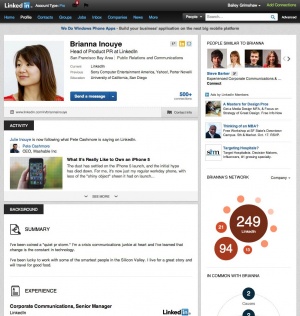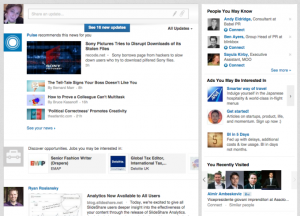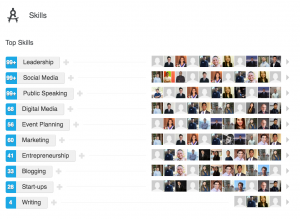Difference between revisions of "LinkedIn"
(updated ethical issues section) |
(Elaborating on LinkedIn recommender system under "Ethical Concerns") |
||
| Line 62: | Line 62: | ||
===Recommendation System Privacy=== | ===Recommendation System Privacy=== | ||
While recommender systems may often be useful for users overwhelmed with limitless amounts of data, ethical issues may arise as well. As with other sites that make use of recommendation systems, such as [[Amazon.com]], [[Facebook]], and [[YouTube]], there is always a chance that recommendations are not useful or appropriate for the user. The LinkedIn system uses an algorithm to suggest professionals you may know, companies you may want to follow, and develops a tailored news feed based on information on your profile and your connections' profiles. The issue stands in relation to user privacy and the amount of information extracted (often unknowingly) to make these recommendations.<ref>Gupta, Abhishek. [http://www.quora.com/LinkedIn-Recommendations/How-does-LinkedIns-recommendation-system-work?goback=%2Egde_770517_member_162004339/ "Linkedin Recommendation System."] Retrieved on 10 December 2012.</ref> Whether users are aware or not of this extensive data extraction, LinkedIn's recommendation system ultimately raises ethical concerns because it collects so much personal information about a large database of users that could be dangerous in the wrong hands. | While recommender systems may often be useful for users overwhelmed with limitless amounts of data, ethical issues may arise as well. As with other sites that make use of recommendation systems, such as [[Amazon.com]], [[Facebook]], and [[YouTube]], there is always a chance that recommendations are not useful or appropriate for the user. The LinkedIn system uses an algorithm to suggest professionals you may know, companies you may want to follow, and develops a tailored news feed based on information on your profile and your connections' profiles. The issue stands in relation to user privacy and the amount of information extracted (often unknowingly) to make these recommendations.<ref>Gupta, Abhishek. [http://www.quora.com/LinkedIn-Recommendations/How-does-LinkedIns-recommendation-system-work?goback=%2Egde_770517_member_162004339/ "Linkedin Recommendation System."] Retrieved on 10 December 2012.</ref> Whether users are aware or not of this extensive data extraction, LinkedIn's recommendation system ultimately raises ethical concerns because it collects so much personal information about a large database of users that could be dangerous in the wrong hands. | ||
| + | |||
| + | When inviting another user to connect, a user has to provide how they know the user with one of these options: listing them as a “Colleague” and clicking one of their current or previous employments; listing them as a “Classmate” and providing the school they both attend[ed]; saying “We’ve done business together” and listing one of their current or former employers; listing them as a “Friend;” replying “Other” and adding their email address (to ensure they knew them outside of LinkedIn); or selecting the option “I don’t know [user].” This system is instituted in an effort to combat spamming and harassment of other users to ensure that consumers maintain professional interactions, and it is certainly abnormal to select the “I don’t know [user]” option; your account may actually become restricted for sending too many invitations with this response <ref>[https://help.linkedin.com/app/answers/detail/a_id/1386 "Why has my account been restricted?"] Retrieved on 25 April 2016</ref>. | ||
==See Also== | ==See Also== | ||
Revision as of 15:56, 25 April 2016
|
Contents
History
The idea of LinkedIn was first thought of by the site's co-founder, Reid Hoffman. A year later in May of 2003, the website became official and a month later, 4,500 members had already joined the website. At the end of 2003, there were more than 81,000 members and by 2004, there were over one million.[3]
Reid Hoffman, the prior CEO was previously a Yahoo executive who helped launch Linkedin. Some other notable founders involved people from PayPal, Socialnet.com, Electronic Arts, Microsoft and more.[4] Currently, LinkedIn generates funds from three main sources: premium subscriptions, corporate solutions, and advertisements.[3] A new member joins LinkedIn about every two seconds, and it is notable that all Fortune 500 executives have LinkedIn accounts.[3]
Uses
Here are some features that are unique to LinkedIn:
- Having a resume automatically created using the built in work experiences and educational background, or having the ability to upload their own resume.
- The ability to write recommendations for other users to highlight experience and skills.
- The ability to find jobs and bookmark them for later use.
- The ability to create a list of skills that a user possesses.
- The ability to view who has viewed your profile.
- The ability to give endorsement points for each of an individuals skills.
Another new feature that is similar to that of twitter is the ability to now "follow" individuals profiles, and so when they post anything new, a user can see notifications.
LinkedIn is the only social media platform that focuses solely on business and professional material. It provides a way to grow professional connections even if two people have never met before. It gives the opportunity to show off one's professional work, skills, and experiences, and consequently offers more opportunities for jobs. With the ability to search specific skills, recruiters can find people fairly easily and vice versa. LinkedIn provides users with a massive network with information and data with just a simple glance. Thus, this platform saves both time and resources so that users and recruiters can both scope out a person or company before meeting them in order to save time and maximize efficiency.
LinkedIn has saved time not just in doing research but also in the application process for most companies. When filing out an application online, most employers give the opportunity to upload their LinkedIn profile in order to get a jump-start on creating a profile and job application with their company. This is the only social networking site that consistently has this option for most job boards and applications. The idea is to consolidate all professional information into one area and then pass that link around, rather than filling out the same information every time one applies to a company.
Membership
LinkedIn has more than 410 million users. Major competitors like Viadeo and Xing are much further behind with 35 million and 10 million respectively.[5][6][7] At the current membership growth rate, LinkedIn gains about 2 new users every second.[8] About half of all current LinkedIn users reside in the United States. However, India currently has the fastest growing LinkedIn network in the world.[9]
Mobile
In 2012, LinkedIn unveiled a new mobile application for the iPhone, Android, and iPad devices. With this application, users can accept invitations, view who has viewed their profile, and share various content and information. Members can also see connections to different companies and can also find job listings. In January 2011, LinkedIn acquired CardMunch, a mobile app maker that scans business cards and converts their data into contacts. LinkedIn plans to integrate this functionality into their services in the near future.[50] In August 2011, LinkedIn revamped its mobile applications on the iPhone, Android and HTML5. Mobile page views of the application have increased roughly 400% year over year according to CEO Jeff Weiner. [10]
Premium Subscription
In addition to the standard membership, LinkedIn has many paid options for recruiters and general employees, which are payable monthly or annually.[11] These options include a number of "InMails", another form of direct messaging that guarantees a response or you get the credit back, more filtered and specific search results, and many more options depending on the account. Premium members also have more advanced search capabilities, thus being able to get more search results efficiently compared to free users. Premium membership also allows users to become OpenLink members, which allows for anyone, even people outside of a user's network to send messages free of charge. When a premium user views a non-premium user's profile, the user is not notified about who it is that viewed the profile, allowing the premium user to remain anonymous.
Advertising
LinkedIn allows account holders to advertise on the social networking website. LinkedIn's advertising service gives users the opportunity to advertise to a specific target audience by specifying job title, job function, industry, geography, age, gender, company name, company size, or LinkedIn Group. Users must choose their budget for the ad campaign, as well as the bid price of how much they are willing to pay for each click or impression of the ad. Users can choose if they want to pay-per-click on the ad (CPC) or per 1,000 impressions of the ad (CPM). Once the user has created the ad, it must be approved to ensure that it follows LinkedIn's specific guidelines, mainly checking to see that the ad is consistent with LinkedIn's professional tone.[12] An ad may be shown on any or all of the specific webpages, including the user's profile page, home page, inbox, search results page, and groups page. Additionally, once an ad campaign has been created, account holders are able to track the progress of the ad on various graphs provided by LinkedIn.[13]
Ethical Implications
Security Breach
In June 2012, LinkedIn was a victim to a security breach that caused millions of user passwords to emerge. A document containing 6.5 million hashed passwords appeared on a Russian online forum, with more than 200,000 decoded. From the document, security advisors around the world found that LinkedIn hashed their user passwords using the SHA-1 algorithm, a very simple algorithm that scrambles a password into a unique set of numbers and letters.[14] The SHA-1 algorithm is a very widely known password algorithm, with free online services to convert passwords and back through the algorithm. LinkedIn invalidated the stolen passwords, but it was not known if other credentials were stolen as well, and people who had their passwords stolen faced even more risks as they may have used the same password for multiple online accounts. LinkedIn faced public criticism as many security experts stated that the company's security systems were not sophisticated enough for modern day standards following the security breach.[15]
Falsified Credentials
Since LinkedIn is a public social networking space, anyone can post or upload their resume materials. However, the easy access to this online space also allows people to falsify parts of their resume, such as as creating fake online alma maters, reporting graduation from faulty alma maters, and creating fake transcripts and recommendations from past employers. The community forum or network of LinkedIn affords employers the chance to eventually root out these falsified documents, but this process can be lengthy and tricky. The advanced technology of computers makes it easy for people to create professional-looking documents and upload them on the Internet, making falsified credentials a vast potential problem for legitimate Linkedin users and employers.
Change of Terms of Service
In August of 2011, LinkedIn changed its terms of service without notifying its users, consequently causing an uproar among users. LinkedIn had started to use the photos, names, and information of friends to create customized advertising for users. A setting to "opt-out" was created, but a notification for the "opt-out" option was only placed on the LinkedIn blog which does not draw as much traffic as the main website.[16] However, within a few days after much backlash, LinkedIn decided to no longer use names and photos of users in advertising campaigns in response to public criticism and uproar.[17]
Recommendation System Privacy
While recommender systems may often be useful for users overwhelmed with limitless amounts of data, ethical issues may arise as well. As with other sites that make use of recommendation systems, such as Amazon.com, Facebook, and YouTube, there is always a chance that recommendations are not useful or appropriate for the user. The LinkedIn system uses an algorithm to suggest professionals you may know, companies you may want to follow, and develops a tailored news feed based on information on your profile and your connections' profiles. The issue stands in relation to user privacy and the amount of information extracted (often unknowingly) to make these recommendations.[18] Whether users are aware or not of this extensive data extraction, LinkedIn's recommendation system ultimately raises ethical concerns because it collects so much personal information about a large database of users that could be dangerous in the wrong hands.
When inviting another user to connect, a user has to provide how they know the user with one of these options: listing them as a “Colleague” and clicking one of their current or previous employments; listing them as a “Classmate” and providing the school they both attend[ed]; saying “We’ve done business together” and listing one of their current or former employers; listing them as a “Friend;” replying “Other” and adding their email address (to ensure they knew them outside of LinkedIn); or selecting the option “I don’t know [user].” This system is instituted in an effort to combat spamming and harassment of other users to ensure that consumers maintain professional interactions, and it is certainly abnormal to select the “I don’t know [user]” option; your account may actually become restricted for sending too many invitations with this response [19].
See Also
References
- ↑ eBiz MBA."Top 15 Most Popular Social Networking Sites." Retrieved on 10 December 2012.
- ↑ Statista. "Numbers of LinkedIn Members." Retrieved on 10 December 2012.
- ↑ 3.0 3.1 3.2 e-Buzz Edge. "LinkedIn's History, Present and Recent Features." 13 May 2010. Retrieved on 10 December 2012.
- ↑ Linkedin Newsroom. "Linkedin: Press Center." Retrieved on 10 December 2012.
- ↑ Fiegerman, Seth. "LinkedIn has 187 Million Users." 1 November 2012. Retrieved on 10 December 2012.
- ↑ O'Hear, Steve."LinkedIn Competitor Viadeo Hits 30 Million Members." 11 May 2010. Retrieved on 10 December 2012.
- ↑ Wauters, Robin. "Social network for business XING hits 10 million members." 27 September 2010. Retrieved on 12 December 2012.
- ↑ Rao, Leena."LinkedIn Now Adding Two New Members Every Second." 4 August 2011. Retrieved on 10 December 2012.
- ↑ Weiner, Jeff. LinkedIn: 50 million professionals worldwide 14 October 2009. Retrieved on 10 December 2012.
- ↑ Li, Anita."LinkedIn Revamps Apps for Smartphones, iPads as Mobile Users Grow." 6 September 2012. Retrieved on 10 December 2012.
- ↑ LinkedIn. "Subscription Plans." Retrieved on 10 December 2012.
- ↑ LinkedIn. "LinkedIn Ads Guidelines." Retrieved on 10 December 2012.
- ↑ LinkedIn."Ads." Retrieved on 10 December 2012.
- ↑ Paul, Ian [1] 6 June 2012. Retrieved on 10 December 2012.
- ↑ Finkle, Jim and Saba, Jennifer."LinkedIn breach puts site's reputation on the line." 10 June 2012. Retrieved on 10 December 2012.
- ↑ Loftus, Tom."Another Social Network Opt-Out Draws Fire."11 August 2011. Retrieved on 10 December 2012.
- ↑ Reputation-Communications.com."LinkedIn & Co: Social Media’s Furtive Little Tricks." Retrieved 10 December 2012.
- ↑ Gupta, Abhishek. "Linkedin Recommendation System." Retrieved on 10 December 2012.
- ↑ "Why has my account been restricted?" Retrieved on 25 April 2016



